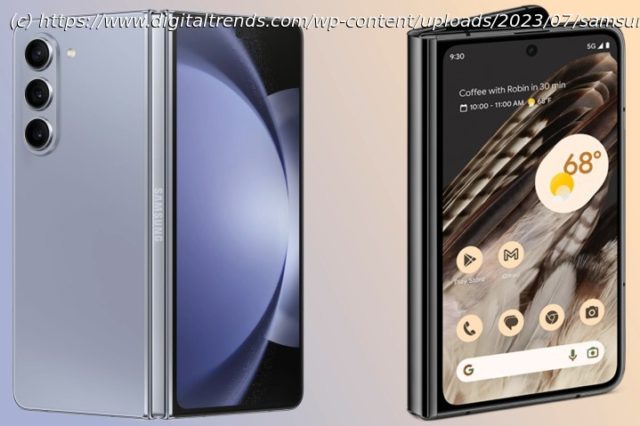The Samsung Galaxy Z Fold 5 and Google Pixel Fold are two of the most expensive foldable you can buy in 2023. Which one is the best? We found out.
In the foldable smartphone arena, there’s little doubt that Samsung has become the heavyweight champion. After all, it’s had nearly four years to refine the experience, and it hasn’t been shy about doing so in public. Last year’s Galaxy Z Fold 4 proved that Samsung’s design was ready for prime time. Now, it’s refining that with the new Galaxy Z Fold 5, a worthy successor that delivers some nice quality-of-life improvements and even more power under the hood.
Samsung may be the foldable smartphone maker to beat, but another notable contender threw its hat into the ring this year. Google entered the market this spring with its own unique take on foldable designs that borrows from its successful seven-year run with the Pixel series.
The Google Pixel Fold is a first-generation device, to be sure, but Google also isn’t some plucky little startup — it has the design and engineering chops to produce something special. The question is whether it’s special enough to unseat Samsung’s dominance or if the South Korean smartphone maker has widened the gap even further with this year’s Galaxy Z Fold 5.Samsung Galaxy Z Fold 5 vs. Google Pixel Fold: specsSamsung Galaxy Z Fold 5 vs. Google Pixel Fold: design and display
If you’ve put your hands on any of Samsung’s Z Fold phones over the past few years, you won’t find too many surprises in the Galaxy Z Fold 5. It’s clear that Samsung has come up with a design that works, so there aren’t any bold changes here, just a few year-over-year refinements, mostly focused on reducing the thickness and weight and improving the hinge.
Similarly, even though the Pixel Fold is Google’s first attempt at a foldable smartphone, the design language of the Google Pixel 7 is readily apparent here. Aesthetically, it feels like what you’d get if you stacked two Pixel phones together, right down to the glass back and eerily similar camera bump.
However, it’s that similarity to the standard Pixel 7 design that sets the Pixel Fold apart from Samsung’s foldable family. Samsung has adopted a narrower “candy bar” style design when closed that feels reminiscent of classic feature phones and some of the earliest foldables, such as Nokia’s E90 Communicator. This results in a cover screen with a 23:9 aspect ratio — much taller and narrower than most folks will be accustomed to. However, if you can get comfortable with the narrow screen, you’ll likely find that the Z Fold 5 feels more comfortable and natural in the hand when folded — and even more so now that it’s thinner and lighter than its predecessor.
To put that in perspective, though, most modern flagship smartphones have a screen aspect ratio of around 19.5:1. This includes the iPhone 14 Pro Max, Samsung Galaxy S23 Ultra, and Google Pixel 7 Pro.
With the Pixel Fold, Google has gone in the opposite direction, widening the screen into a 17.5:9 presentation. This also gives it a proper 1080p HD resolution, which the Galaxy Z Fold 5 falls short of at only 2,316 x 904 pixels.
How much this matters is an open question, but if you like watching videos without unfolding the phone, there’s little doubt that the Pixel Fold will provide a nicer presentation. The downside is that this width makes it feel chunkier in the hand since you’re dealing with a front profile that’s about the same size as a Pixel 7 Pro at nearly twice the thickness.
Further, while the Fold 5’s cover screen may seem larger at 6.2 inches versus the 5.8 inches of the Pixel Fold, diagonal screen sizes can be misleading when dealing with significantly different aspect ratios. In reality, the Pixel Fold’s cover screen actually has a slightly larger surface area at 13.71 square inches, compared to 13.02 square inches for the Galaxy Z Fold 5. That’s not a difference anyone is likely to notice, but it does show that diagonal screen sizes don’t always tell the whole story.
However, once you open both phones up, the screens are on much more equal footing. They have identical sizes and virtually the same resolutions. The main difference is that the Pixel Fold’s inner screen has a more landscape view to it, while the Z Fold 5’s is closer to a square shape.
Home
United States
USA — software Samsung Galaxy Z Fold 5 vs. Google Pixel Fold: $1,800 foldable showdown






